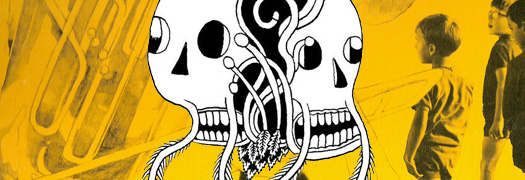
Features | Lists
By The Staff

40 :: Deerhoof
Reveille
(Kill Rock Stars/5 Rue Christine; 2002)
Deerhoof are everything on this list, all at once. They are the dissonant, jagged avant-gardists; the quiet minimalists crooning over soothing atmospherics; the unrepentant noise act whose frantic tempo changes jerk the listener around, shatter eardrums, offend tender sensibilities; and the garage rockers blasting surf hooks bred from chaos. But on Reveille more than on any other Deerhoof record, permeating and overriding the glut of personalities is a childlike innocence that comes not from unsophistication or tinny toy synthesizers, but from an unbridled spontaneity, from guilelessness; this is the band having the fun that Deerhoof should have. There’s adolescent gleefulness to the noise, a cheekiness to the pop fragments, and a playfulness to the lullaby tags and parallel-octave sing-alongs that are about nothing less (or more) than enjoying the process of playing and listening to music. So much of the decade’s best music, including a good chunk of our top 100, is serious, humorless, even dour stuff. Here’s the bailout.
Skip Perry

39 :: William Basinski
The Disintegration Loops
(2062; 2002-2003)
On his most immediate, most notable, and most affecting album, William Basinski seems more a documentarian than a musician. Though he composed the material that makes up these discs in the early eighties, across the four volumes of The Disintegration Loops he doesn’t appear to be composing at all. Instead, he makes his listener witness the sound of music destroying itself, tapes literally playing themselves to death over the course of somewhere between twenty and seventy minutes per recording. Most of them end in a single fragment left intact, a shell of an idea, and it too ceases eventually as everything gives way to negative space and then to silence.
While this in and of itself is certainly striking, there’s also the fact that this is among the most emotionally loaded music ever made. Like few records, The Disintegration Loops confronts longstanding human anxieties—death’s inevitability, the impossibility to achieve any form of real immortality, the fact that everything will one day cease to exist and function as is—not by intellectualizing or overthinking them but merely by displaying them in a form that one can, perversely, relive indefinitely. Basinski has made a career out of melancholic ambient music, but The Disintegration Loops transcends his catalog and almost any competition by making clear, for all to see, the bridge between existence and nonexistence, between life and the void. It’s a gorgeous, occasionally horrifying, and often all too real place.
Andrew Hall
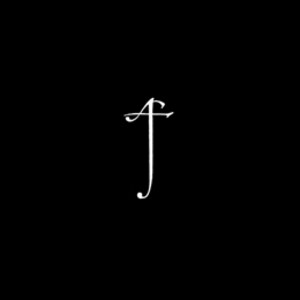
38 :: Pantha Du Prince
This Bliss
(Dial; 2007)
If you want to know what makes Pantha Du Prince great in one posturing conceptual utterance, then hark: Pantha Du Prince is great because he makes dance music that inverts dance music.
OK, OK, to be more specific: Pantha Du Prince (and particularly This Bliss, his best album) rocks not because he inverts the form of minimal techno so much as its function. If the majority of dance music works flawlessly under strobes and on drugs but doesn’t have much value in more sober situations, then Pantha’s music works at home, on the train, in the countryside, anywhere but the dancefloor. Where dance music generally makes sense only in that stable frame of reference—big speakers, low lights, bodies in motion—This Bliss chews up context. (Have you tried it in a snowfall yet? Or walking home late at night? Does it help or hinder during sex?) It almost begs you to push its unexpected versatility.
And yet what’s really here is not much different to the stuff to which it seems diametrically opposed. It still maintains 4/4 beats, the polyphonic arrangement of loops and layers, the add-and-subtract dynamics. In fact, the worst kept secret of dance music is that it could easily make sense outside of a club—which is why it’s often such omnipresent filler for the backgrounds of TV commercials and films—given some simple bass tweaking and a shift in volume. The real trick to it, and the reason we’re not flooded with albums of the calibre of This Bliss, is keeping that 3 AM edge smoldering under the surface. Sure, this is a picturesque record—it’s almost impossible to mention the delicate strings of “Saturn Strobe” without uttering a word as blasphemous as “cinematic”—but it maintains an edge of ketamine creepiness even in its prettiest moments. Whatever the situation, it never merely soundtracks its surroundings but always actively defamiliarises them, finding beauty, fragility, and melancholy in unexpected corners. While Pantha’s subsequent efforts have sat a little too close for comfort to wind chime wallpaper music, This Bliss hits the sweet spot, subverting dance music methodology to create something that absolutely refuses to stay in the background.
notextile.
Jack Moss

37 :: Interpol
Turn on the Bright Lights
(Matador; 2002)
For a long time, my only experience with Interpol was tangential: a girl in my law school class once dated the bass player for a month in college and deemed him a horrible human being; another friend saw them at NYC’s now-defunct Brownies and labeled them a Joy Division knock-off. They seemed like a band I was meant to casually hate from the beginning. Especially when I finally saw them in late 2001 play for twenty-five minutes to seventy people waiting for Ash to come on—they had zero stage presence, a bunch of black clad sad-sacks who, on account of frontman Paul Banks’s baritone and a reliance on post-punk bass lines, did indeed sound more like Ian Curtis and co. than I was ready to comfortably accept.
But fast forward to July 2004: Turn On the Bright Lights has been out for a little over two years, Interpol has second billing on the main stage at the Cure’s Curiosa festival, and the crowd is absolutely eating out of the band’s collective hand. Despite the 90-degree weather, Carlos D is wearing a gun holster and dressed head to toe in black, smirking at his bass like the thing could up and play itself. Paul Banks has his cigarette breaks down to a science; the band is radiating confident cool—all the more impressive considering it’s 4:30 in the afternoon.
In a remarkably short time Interpol had transformed from chic cover band to a cohesive distillation of everything exciting about New York indie rock in 2002. Thus, I sold my copy of Massive Attack’s 100th Window (2003) and used the store credit to purchase Bright Lights; once I was greeted with a shimmering guitar figure and molasses-thick, Stone Roses-inspired bass line, I was fully assured I had made a good decision. Whereas “Untitled” plays up Interpol’s debt to early 90s shoegaze with a monstrous wash of reverb and dive bombing guitar lick (owing something to Kevin Shields’s “glide” technique), second track “Obstacle 1” retools Joy Division as an extremely well-oiled machine. The similarities, of course, are plainfaced—clipped guitar downstrokes, post-punk bass, violent imagery (“Stabbing / Yourself / In the NECK!”)—but Paul Banks’s unshakeable confidence stands in for Ian Curtis’s nervous energy, and Interpol seems entirely less morose.
Interpol’s influences, if this hasn’t been made clear by now, are certainly overt: Turn On the Bright Lights welds a variety of 80s Brit-pop signifiers to reverb-drenched production and the lock-step rhythm section of Carlos D and drummer Sam Fogarino. “Say Hello To the Angels” completely rips both the riff and rhythm cadence from the Smiths “This Charming Man,” and jittery rockers like “PDA” and “Obstacle 2” could have come from any number of bands playing the Factory circa 1980. But it was perhaps because of the band’s seamless synthesis of so many touchstones, along with debut records from the Strokes, the Walkmen, and Yeah Yeah Yeahs, that Interpol led the pack of 2002 New York City Bands drooled over by the British hype rags. They were poised to conquer the w
orld.
We now know that didn’t exactly happen. Antics (2004) was the retread that was both very possible and very dreaded by many fans, and Our Love To Admire (2007) was garbage (plus, they got totally out-Interpoled by the Horrors on that band’s Primary Colours [2009] album). It’s been a long time since Interpol’s been in anything of an underdog position, and now they’re hinting that their forthcoming fourth album will be an enduring fan’s dream, capturing the spirit of the original (reverb has been emphasized) while pushing them forward. If Turn on The Bright Lights is any indication, this band’s always been capable of upending expectations.
David M. Goldstein
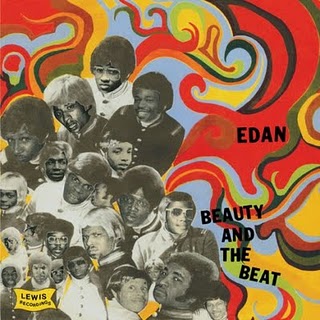
36 :: Edan
Beauty and the Beat
(Lewis; 2005)
Edan Portnoy was talking to Clay when he referred to straight kicking it as “reaching higher levels of spirituality,” which…wow. I mean, I know what old boy’s talking about. He’s talking about sitting on his couch. He’s talking about smoking a blunt and playing Braid for six hours, fielding texts lazily and with effort. Throwing himself around the orbit of his apartment with entropic gusto. I know this because I do it all the time, but never once did it occur to me to euphemize that malaise as seeking out higher levels of spirituality.
But that’s why I’m not Edan. I don’t think of literally everything I do in terms of the language of artistry. Production masterpiece Beauty and the Beat is not only conclusive and evocative proof that Edan does just that, but a seamless example of the benefits of that discipline. To think of rap as art is a position long ago staked out and normalized by artists, critics, and philosophers who trace its roots back through R&B and soul to the Harlem Renaissance and further into the darkened past. Edan seems to have little use for that kind of intellectualization or justification, instead weaving themes into samples into beats into rhymes in an organic mélange that suggests it never would have occurred to him to treat rap as anything but art. And not just art, but a medium every bit as expansive and, well, beautiful as any conventional oil on canvas or bit of twisted wood and wire on display at the MOMA.
Rap-as-beauty can be a tough sell though, in a genre that has gone no small lengths to seem percussive and intimidating; this classic art proclivity could have ruined Beauty had the emcee fallen prey to the temptation to overstate his case. “Art” could have taken the familiar bloated form of protracted wankery or knob-twiddling self-gratification. The avoidance of this impulse is the pulsating little photon of brilliance that booms and baps from the wavy scratches of “Polite Intro” to the two-steps-forward-one-step-back hopscotch skip of “Promised Land.” Beauty manages to sacrifice no element of rap in order to be artistic and no element of artistry—from encyclopedic samples to translucent impressionism in the flows—in order to conform to the perceived requirements of a rap record.
And yet this is fully a rap record and fully an artistic manifesto. This is not Edan saying to us: “We can have both, y’all, the Beauty and the Beat.” This is Edan saying to us: “We do have both, y’all. We already have them. They’re the same thing. Here they are holding hands and shit.” No stale grad-level formulations of “rap can be art” or “we can think of rap that way” but, instead, “of course rap is art, dumbass.” There should be no other way of thinking about it. And at least for the half-hour or so in which you’re spinning Beauty and the Beat there is no other way.
Eric Sams
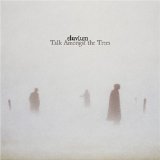
35 :: Eluvium
Talk Amongst the Trees
(Temporary Residence; 2005)
If Fennesz’s Endless Summer is like-or-as-pertaining-to-beauty filtered through industrial-strength loudspeakers to make monolith of nostalgia, Eluvium’s stately Talk Amongst the Trees is the astute simplification of mythological narrative. It’s as if the mass-marketed hysteria of the 2000’s newly revived cinematic epic were boiled down and drugged into its barest, sparest, most essential skeleton—Peter Jackson on a hallucinatory starvation diet, forced to ruminate, in an hour or less, on what it is about Lord of the Rings that resonates with him rather than add another CGI sequence to an endless plot. But the album is also more than just finely scoped ambient: the gradual two-chord shift in the eighth minute of opener “New Animals from the Air” also creates dramatis personae so unannoyingly patient, borne of cyclicism and miniscule elaboration, that it reveals both the artist’s scope and skill. Mathew Cooper doesn’t seem at all interested in expanding the boundaries of musical mechanism, or even of ambient; he is as comfortable in the genre’s more-than-sufficiently-expanded confines as any ambient musician on this list.
Much more Max Richter or canonical Eno than Stars of the Lid boops or Keith Fullerton Whitman crackle, Talk Amongst the Trees seems evidence of not just a historical, but a historiographical awareness; it’s almost minimalist classical rather than ambient. Centerpiece “Taken” builds inexorably but with nuance towards an immaculately plotted climax that is no less haunted for repeated listening. “Everything to Come” is less pastiche than starkly intentional and unerringly linear; what repetition exists does so not because Cooper has any investment in breaking down the structures of his music, but because repetition is as integral to storytelling and interpretation as melody is to concepts of beauty. What Cooper has created is that rarity of a populist ambient record, with both narrative heft and precise loveliness.
Conrad Amenta
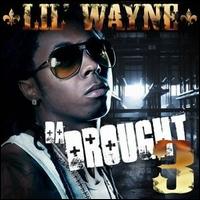
34 :: Lil Wayne
Da Drought III Mixtape
(Young Money; 2007)
You’d be forgiven for expecting our obligatory Weezy F Baby best-of selection to be the more definitively canonical Tha Carter III (2008), but if the plan is to celebrate an artist whose free online offerings consistently trump the strongest material his major-label contemporaries necessarily charge for, why subordinate the significance of his two-disc mixtape masterpiece to the established stature of its multiplatinum alternative? Does its availability through more traditional channels, its status as the “official” opus (=marketable commodity readily purchasable at big-box outlets), make it the default career-defining product? Tha Carter III is certainly a great record, but it’s also far less reflective of the qualities that made Lil Wayne the decade’s dominant hip hop personality: Tha Carter III, in sharp contrast to Da Drought III‘s leisurely swagger, feels just a little too composed, as though Weezy’s inconsistencies had been sanded off, at the expense of some his most charming idiosyncrasies being stifled, in order to make him a more viable commercial property. That album’s most enduring tracks, like the ubiquitous “A Milli,” still trade in his trademark weirdness, but that weirdness there seems comparatively cultivated. And cultivation—as well as, sure, some quality control—doesn’t much factor in to Weezy’s mixtape output.
And so with Da Drought III we get 29 tracks of syrup-soaked Carter delirium, an indulgent glut of Weezy clocking in at well over 100 minutes. And though there are occasional dips in quality there’s also just so much great hip hop crammed in here that as a total package it is as audacious as it is undeniable. On album-defining tracks like “Blooded,” Wayne’s gang-anthem take on Young Jeezy’s already-awesome “I Luv It,” the Best Rapper Alive has never sounded so laid-back or lucid. That’s what’s so great about these mixtapes, and this headrush in particular: Lil Wayne just loves rapping, loves poaching beats from the airwaves with no regard for pedigree of prominence (thus we get Beyonce or T.I. on one track and Gnarls Barkley or Ciara on another; he just takes “whatever songs are on,” as he describes it), and nowhere but on catch-all mixtapes like Tha Drought III is that boundless creative vitality captured so convincingly.
Calum Marsh
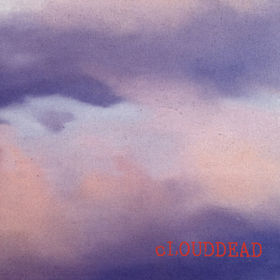
33 :: cLOUDDEAD
cLOUDDEAD
(Mush; 2001)
Of course this made our list. How could we deny a record that so perfectly reflects our critical sensibilities back at us? cLOUDDEAD is dense, literate, potentially pretentious, spiritedly communal, interested in hip-hop but also ambient and noise and even regular old indie rock, and woefully neglected or underappreciated by the music-loving masses. We don’t want to listen to this record so much as ask it to move in with us.
But in a weird way it wouldn’t have been an appropriate choice for #1: this album feels more at home just outside of the spotlight, loved proudly but not flaunted, a trade-secret you almost don’t want to share (but know you probably should). Because list-topping bests always feel abstractly like the best; they’re resolutely Important albums, perceived that way at least in part because they present themselves as such. cLOUDDEAD never asserts itself in that way, never comes on strong though it does resonate strongly, because for all the emotional density and linguistic intricacy and subversion of convention going on in here, this record still seems understated and, ahem, quite subtle. Compare the record’s take on those qualities to almost any other that boasts the same—the overtly audacious Illinoise (2005), say, or this year’s inflated critical darling Have One On Me— and the degree to which cLOUDDEAD downplays its own arthouse difficulty, how it refrains from recognizing itself as the near-perfect debut it clearly is, becomes apparent. This is something of a masterpiece but it wears the clothes of a minor work, its cerebral extravagances shrugged off like no big deal, just Yoni and Dose and Odd Nosdam hanging out and being clever (but not conceitedly so), the end product a nonchalant but totally compelling work of gorgeous sorta-rap that sounds like pretty much nothing else—except, of course, anything else these guys have worked on.
And we really love most everything these guys have worked on. Them (2000), Plan 9…Meat Your Hypnotist (2001), Alopecia (2008), hell, even the Chet-adored Celestial Clockwork (2004) from cLOUDDEAD guest Illogic—these are just a few great albums that we’d like to acknowledge but for one reason or another aren’t on this list. (Also, Deep Puddle Dynamics’ Taste Of Rain, Why Kneel, which did make the list, before we realized, way later, that it came out in 1999.) But, Subtle notwithstanding, cLOUDDEAD provides the best summation of all the things that make Anticon’s less canonical output so appealing: it’s a heartening argument on behalf of the intellect, the championing of abstraction over things made uninterestingly clear. We can only hope to live up to that.
Calum Marsh

32 :: Constantines
Constantines
(Three Gut; 2001)
Canonization works in mysterious ways. We cannot know, exactly, why Shine A Light (2003) seems generally considered the finest Constantines record. I suspect it’s because Sub Pop released that album internationally, while Toronto label and Canadian best-kept secret Three Gut Records released the self-titled debut. This is just a theory, but when Sub Pop reissued the debut in 2004 it was old news to us Canadians. I hereby place all of the Glow’s critical weight (such as it is) behind the following: Constantines is the best Constantines album by a considerable margin. Whatever merits inhere in later records are fresher, more explosive, and less compromising in this, their magnum opus.
Almost from the first moment, Constantines sounds a call to heed rock’s disgraced saints and dead southern dreams. Machine gun guitars and snare-on-all-four-beats drums dominate “Arizona” as Brian Webb gruffs out one of his signature blue-collar epics. One of the most anthemic voices in ‘00s indie, Webb’s choruses read like modern masses protesting and tearing walls down. “Young Offenders” offers an equal amount of muscle, and when it descends into the half-time breakdown its as if hell itself has opened to spew more fury than can ever be comprehended by angst. With such grand heights reached using such minimal tools (guitars, drums, unadorned production), songs like these earn the Constantines all those Springsteen comparisons and provide some of the best fists-up moments of the decade.
Like Nirvana at their least playful, the Constantines summon such uncompromised anger and total resistance that it seems like they’re saying, “fuck everything, even rock and roll.” But what’s amazing us how they use that P.F.O.: at the heart of all this no-saying lies a gritty kind of hope, like expressing all of this anger holds out for the possibility, however remote, of a better life to come.
David Ritter

31 :: Arcade Fire
Funeral
(Merge; 2004)
Funeral‘s September release in 2004 was a significant event for fans and practitioners of contemporary indie rock; by re-injecting sentimentality into rock (emotions having been trendily shed by the post-Strokes guitar hero set) Arcade Fire capitalized on an indie-friendly environment bolstered by “Float On” and Garden State and fostered a rise of the indie underground into wider public consciousness. And we can debate whether “indie” ever meant anything tangible prior to 2004, but it’s only slightly reductive to say that what “indie” means now in a popular sense it means in a large part due to Funeral, for better or worse: what new bands sound like, how we hear about them, and who critiques them and who cares. When non-music snobby people find out you’re a music snob, Funeral just might be the album they want to talk about. Suddenly, these people and David Bowie aren’t that far apart.
Not that I had any real conception of this in September of 2004. That was the month I moved out of my small-town home in order to attend my big-city University. But I can’t imagine a better time in my life to have been given Funeral, an intensely moving record worth, ten years later, getting nostalgic over. This is because the album encourages us to reminisce about the joy and sadness of our younger years by exploring the innocence of youth and the inevitability of death (and all the many years that come between). It’s about disenchantment, disappointment, desperation—the heartbreak wound up in the vicissitudes of daily life. And yet, for all that sadness, it so frequently sounds hopeful and even, at times, celebratory: it’s sad when someone dies but isn’t it fucking great that they were even alive? That any of us are? Let’s keep in mind that in 2004 that was something of an unfashionable sentiment, too broad and self-serious and uncomplicated to even relate to contemporary releases like Blueberry Boat and Antics.
Judging by the number of sentimental copycats to have sprung up since, this was clearly a long-overdue clarion call: suddenly garish gestures were ready-made tools of emotional expressiveness, brevity and concision were made bleak, and a new band could never have too many members. Also, xylophones became popular. Whatever you think about Funeral as a set of music, it’s difficult to imagine what the last six years of indie culture would have looked like had Funeral never existed. Be glad the Arcade Fire’s idea was so elegant.





